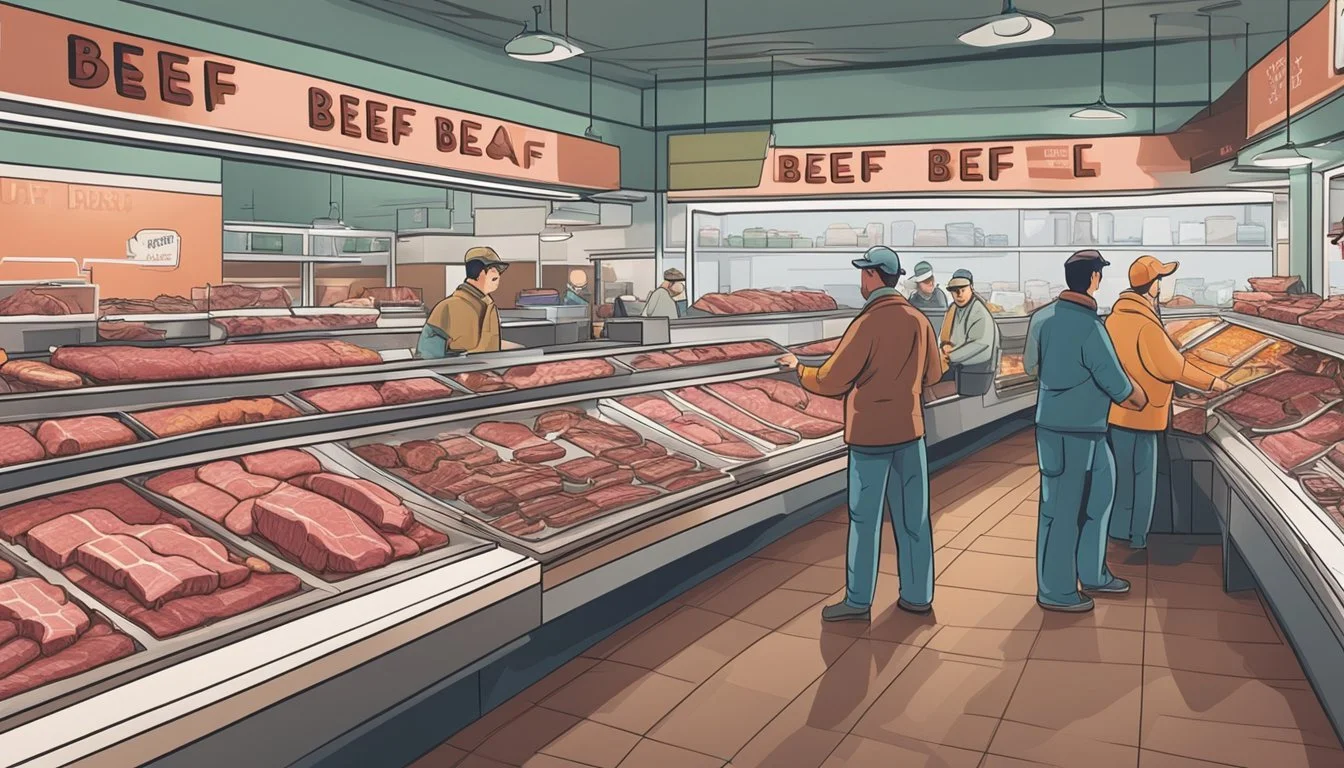Prime Picks: Unveiling the Best Grocery Stores for Quality Beef
Finding high-quality beef at the grocery store can elevate any meal from ordinary to exceptional. While many chains offer decent selections, some stand out for their superior meat departments. Whole Foods Market consistently ranks as the top nationwide grocer for premium beef, offering both USDA Prime cuts and organic grass-fed options.
Shoppers seeking top-tier beef can also find excellent choices at specialty stores like Wegmans, which features dry-aged beef in glass-walled coolers at select locations. For those prioritizing value without sacrificing quality, Safeway provides a wide range of USDA Choice beef cuts at competitive prices. Their ground beef options cater to various preferences, including leaner ratios perfect for health-conscious consumers.
Other notable contenders in the beef department include Stater Bros., praised for its quality meats and customer service, and Sprouts Farmers Market, which garnered positive reviews from consumers for its selection. When seeking the best beef, considering factors like grading, sourcing, and store reputation can help shoppers make informed decisions.
Understanding Beef Quality and Labels
Selecting quality beef involves understanding grading systems, marbling characteristics, and production methods. These factors significantly impact taste, texture, and nutritional value.
USDA Grading and What It Means
The USDA grades beef based on marbling and maturity. Prime is the highest grade, featuring abundant marbling and superior flavor. Choice follows, offering high-quality beef with less marbling than Prime. Select is leaner with minimal marbling, potentially resulting in less tender meat.
USDA grading is voluntary and not all beef receives a grade. Ungraded beef can still be of good quality but lacks official classification.
Prime beef accounts for a small percentage of graded beef. It's often found in high-end restaurants and specialty butcher shops.
Marbling and Texture
Marbling refers to the intramuscular fat visible within beef cuts. It contributes to flavor, tenderness, and juiciness.
Higher grades like Prime and Choice have more marbling. This fat melts during cooking, enhancing taste and texture.
Beef texture varies based on the cut and grade. Well-marbled cuts tend to be more tender and flavorful.
Age of the cattle also affects texture. Younger animals typically produce more tender meat.
Grass-Fed vs. Grain-Fed Beef
Grass-fed beef comes from cattle raised primarily on pasture. It's often leaner than grain-fed beef and may have a distinct flavor profile.
Grain-fed cattle are typically finished on a diet of corn or other grains. This produces beef with more marbling.
Aspect Grass-Fed Grain-Fed Flavor Earthier Richer Fat Less More Omega-3 Higher Lower
Some consumers prefer grass-fed beef for its perceived health benefits and environmental considerations. Others favor the taste and texture of grain-fed beef.
Organic beef can be either grass-fed or grain-fed but must meet USDA organic standards.
Top Grocery Stores for Beef Selection
Selecting the right grocery store for beef can significantly impact quality, variety, and value. Several major chains and local options stand out for their beef offerings, each with unique strengths.
Whole Foods Market: Premium Meats and Organic Options
Whole Foods Market is renowned for its high-quality beef selection. They offer a wide range of organic, grass-fed, and locally sourced options. Their meat department adheres to strict animal welfare standards.
Customers can find dry-aged beef, prime cuts, and specialty items like wagyu. Whole Foods also provides detailed information about their beef's origin and raising practices.
Their butchers are knowledgeable and can offer custom cuts upon request. While prices tend to be higher, the quality and ethical sourcing justify the cost for many shoppers.
Costco: Bulk Purchase and Quality
Costco's meat department is a go-to for bulk buyers seeking quality at competitive prices. Their beef selection includes USDA Choice and Prime grades, offering excellent value.
The warehouse chain carries a variety of cuts, from ground beef to prime rib roasts. Costco's Kirkland Signature brand beef is known for consistent quality.
Vacuum-sealed packaging allows for longer storage, ideal for those buying in larger quantities. While the selection may be more limited than specialty stores, Costco's beef quality rivals many higher-end grocers.
Trader Joe's and Aldi: Value and Quality
Trader Joe's and Aldi offer budget-friendly options without compromising on quality. Both stores carry a selection of organic and grass-fed beef options.
Trader Joe's focuses on pre-packaged cuts, including marinated varieties for added convenience. Their beef is hormone and antibiotic-free.
Aldi's beef selection, while more limited, provides good value. They offer both conventional and organic options.
These stores are ideal for shoppers looking for quality beef at lower price points, though the variety may be less extensive than larger supermarkets.
Wegmans and Publix: Selection and Service
Wegmans and Publix are known for their extensive meat departments and excellent customer service. Both offer a wide range of beef cuts and grades.
Wegmans features a dry-aging room in some locations, catering to beef connoisseurs. They also carry local and organic options.
Publix is praised for its knowledgeable butchers and willingness to accommodate special requests. Their beef selection includes USDA Choice and Premium grades.
These stores strike a balance between quality and affordability, with options to suit various preferences and budgets.
Local Butchers and Farmers Markets: Freshness and Sourcing
Local butcher shops and farmers markets offer unique benefits for beef enthusiasts. These sources often provide the freshest cuts and most direct farm-to-table options.
Local butchers typically source from nearby farms, ensuring transparency in the supply chain. They can offer custom cuts and expert advice on preparation.
Farmers markets allow consumers to buy directly from producers. This option provides the opportunity to learn about raising practices and support local agriculture.
While prices may be higher and availability more limited, the quality and personal touch of local sources are unmatched for many beef lovers.
Evaluating Meat Departments
Meat departments form a crucial part of grocery stores, offering a range of products and services that can significantly impact the quality of customers' shopping experiences. The expertise of staff, variety of offerings, and specialized processes all play key roles in determining the overall value of a meat department.
The Role of a Knowledgeable Butcher
A skilled on-site butcher is invaluable to a meat department. State-certified meat cutters provide expert advice on cuts, cooking methods, and meat selection. They can offer custom cuts, trimming services, and recommendations based on individual customer needs. Butchers also ensure proper handling and storage of meat products, maintaining freshness and quality standards.
Knowledgeable butchers can guide customers through various meat grades, explaining the differences between USDA Prime, Choice, and Select beef. They may also educate shoppers on less common cuts or specialty meats, enhancing the overall shopping experience.
Fresh Meat vs. Prepared Meat Options
Meat departments typically offer both fresh and prepared meat options. Fresh meat includes unprocessed cuts like steaks, roasts, and ground beef. These allow customers to prepare meals from scratch according to their preferences.
Prepared meat options cater to convenience-seeking shoppers. These may include marinated meats, pre-seasoned burgers, or ready-to-cook kebabs. Some stores offer a wider range of prepared items, such as stuffed pork chops or bacon-wrapped filets.
The balance between fresh and prepared offerings can vary. Stores with extensive prepared meat selections may appeal to busy consumers, while those emphasizing fresh cuts might attract cooking enthusiasts.
Significance of In-House Aging Processes
In-house aging processes, particularly dry-aging, can set a meat department apart. Dry-aging beef enhances flavor and tenderness by allowing natural enzymes to break down muscle fibers. This process requires specialized facilities and expertise.
Stores offering dry-aged beef demonstrate a commitment to quality and may attract discerning customers. The aging process typically lasts 14-28 days, resulting in a more intense, nutty flavor profile.
Not all stores have the capacity for in-house aging. Those that do often showcase their dry-aged products prominently, highlighting the unique characteristics and premium nature of these meats.
Ethical Practices and Animal Welfare
Ethical sourcing and animal welfare have become increasingly important factors for consumers when choosing where to buy beef. Leading grocery stores are responding by implementing rigorous standards and offering more sustainable and humanely raised options.
Sustainable Sourcing and Environmental Impact
Many top grocery chains now prioritize sustainable beef sourcing practices. Some partner directly with ranchers who use regenerative grazing methods that improve soil health and sequester carbon. Others focus on reducing packaging waste and transportation emissions in their supply chains.
Whole Foods has implemented a four-step Animal Welfare Rating system for their beef. This encourages more sustainable farming practices among their suppliers. Sprouts Farmers Market emphasizes locally sourced beef to reduce transportation impacts.
Some stores offer grass-fed and grass-finished beef options. These typically have a lower environmental footprint than conventional grain-finished beef. Consumers can often find detailed information about sourcing practices on store websites or product labels.
Antibiotic-Free and No Added Hormones
Leading grocery stores are expanding their selections of antibiotic-free and hormone-free beef. This addresses growing consumer concerns about antibiotic resistance and potential health impacts of added hormones.
Whole Foods prohibits the use of antibiotics and added growth hormones in all their fresh beef. Sprouts Farmers Market and many other chains offer extensive selections of antibiotic-free options.
Some stores go further by offering beef from cattle never treated with antibiotics, even for illness. This practice is becoming more common, especially for organic and premium beef lines.
Certifications and Animal Welfare Standards
Third-party certifications help consumers identify beef raised to higher animal welfare standards. Common certifications include Global Animal Partnership (GAP), Animal Welfare Approved, and Certified Humane.
Whole Foods requires GAP certification for all their fresh beef. This ensures animals are raised with access to the outdoors and without cages or crates. Bristol Farms sources USDA Prime and Choice beef that meets specific ethical standards.
Many stores now offer Certified Angus Beef, which has its own set of quality and ethical requirements. Transparency is key - leading grocers provide detailed information about their animal welfare policies and certification standards online and in-store.
Price Comparison and Value
Grocery stores offer a range of beef options at various price points. The cost of beef can vary significantly based on quality, cut, and store policies. Some retailers focus on affordability, while others emphasize premium selections.
Budget-Friendly Options
Aldi stands out for its consistently low meat prices. Their simplified business model allows them to offer beef at competitive rates. Ground beef is often one of the most affordable options, with 80/20 lean-to-fat ratios common in many stores. Walmart and Target also provide budget-friendly beef choices, though selection may be limited.
Some stores offer store-brand beef at lower prices than name-brand alternatives. These can provide good value for shoppers on a tight budget. Bulk purchases or family packs often come with per-pound discounts, making them attractive for cost-conscious consumers.
Mid-Range and Expensive Cuts
Safeway and Wegmans are known for their quality beef selections, offering a range of mid-priced to premium options. USDA Choice beef is commonly available at these stores, providing a balance of quality and affordability. Whole Foods focuses on organic and grass-fed beef, which typically commands higher prices.
Premium cuts like ribeye, filet mignon, and aged beef are generally more expensive. These are often found in specialty meat departments or high-end grocery stores. Prices for these cuts can range from $15 to $30 per pound or more, depending on quality and origin.
Discounts and Grocery Store Sales
Many grocery stores run weekly meat specials, offering significant discounts on select beef cuts. These sales can provide opportunities to purchase higher-quality beef at reduced prices. Some stores offer loyalty programs or digital coupons for additional savings on meat purchases.
Seasonal sales, such as those around major grilling holidays, often feature beef discounts. End-of-day markdowns on fresh meat nearing its sell-by date can offer substantial savings for immediate use or freezing. Some stores also provide bulk discounts or special pricing for larger quantities, benefiting those who can store extra meat.
Additional Meat Options and Alternatives
Grocery stores offer a diverse range of protein choices beyond traditional beef cuts. These options cater to various dietary preferences and culinary tastes.
Poultry, Pork, and Lamb Selections
Chicken remains a popular choice, available in whole birds, breasts, thighs, and wings. Many stores stock free-range and organic options. Pork offers versatility with cuts like chops, tenderloin, and ribs. Bacon and sausages are common pork products.
Lamb provides a rich flavor profile. Shoppers can find lamb chops, leg of lamb, and ground lamb. Some stores offer pre-seasoned lamb options for convenience.
Quality varies between stores. Look for fresh meats with clear labeling on origin and production methods. Many grocers now provide detailed information on animal welfare practices.
Game Meats and Exotic Choices
Bison has gained popularity as a leaner alternative to beef. It's often available ground or as steaks. Venison, duck, and rabbit appear in specialty meat sections of larger stores.
Some grocers stock more exotic options like ostrich or alligator meat. These choices appeal to adventurous eaters and those seeking unique protein sources.
Game meats typically have stronger flavors and lower fat content compared to conventional meats. They often come from smaller producers or specialty suppliers.
Vegetarian and Vegan Alternatives
Plant-based options have expanded significantly in recent years. Tofu, tempeh, and seitan are traditional meat substitutes found in most stores.
Newer products like Beyond Meat and Impossible Foods offer plant-based burgers that closely mimic beef. These items are often located near fresh meats or in dedicated vegetarian sections.
Many stores now carry plant-based versions of chicken, sausages, and even fish alternatives. These products cater to vegetarians, vegans, and those reducing meat consumption for health or environmental reasons.
Protein content varies among alternatives. Some, like Beyond Meat burgers, provide comparable protein to beef patties. Others may have lower protein levels but offer other nutritional benefits.
Consumer Insights and Shopping Tips
Informed consumers can make smarter choices when purchasing beef at grocery stores. Understanding customer feedback, marketing strategies, and convenience factors helps shoppers get the best value and quality.
Reading Customer Reviews and Ratings
Online reviews and ratings provide valuable insights into beef quality at different grocery stores. Check popular review sites and grocery apps for recent customer experiences. Pay attention to comments about freshness, taste, and value for money. Look for stores with consistently positive feedback on their beef selection and butcher services.
Consider joining local community groups or forums where people share their grocery shopping experiences. These can offer candid opinions about which stores have the best beef deals or highest quality cuts.
Remember that individual experiences may vary, so look for overall trends rather than isolated complaints or praise.
Navigating Marketing and Sales Tactics
Grocery stores use various marketing techniques to promote their beef products. Be aware of common tactics to make informed decisions. "Loss leaders" are items priced below cost to attract customers - these can offer good value but may have limited availability.
Compare prices per pound rather than package prices. Bulk discounts can save money, but only if you'll use the meat before it spoils. Watch for seasonal sales and holiday promotions on popular cuts.
Look beyond flashy packaging and buzzwords. Terms like "premium" or "gourmet" aren't regulated and may not indicate higher quality. Instead, focus on USDA grades and factual information about the beef's source and processing.
Maximizing Convenience and Service
Many grocery stores offer services to enhance the beef-buying experience. Take advantage of butcher counters for custom cuts, cooking advice, and freshness guarantees. Some stores provide free marinades or seasoning when you purchase certain cuts.
Consider delivery or curbside pickup options for added convenience. Check if your preferred store offers these services and any associated fees or minimum purchase requirements.
Loyalty programs can provide additional value through personalized discounts or points on beef purchases. Sign up for email newsletters to stay informed about special offers and new product arrivals in the meat department.






